In 2014 Kim Jong-un embarked on a programme to massively increase international tourism into North Korea, it being one of the few ways in which foreigners could (and can) legally engage with the country, most other avenues being frustrated by US lead international sanctions. Separately the United States barred, and continues to bar, its citizens from travelling to North Korea, except under very limited circumstances.
A key component of Kim Jong-un’s plan was the establishment of the Wonsan Special Tourist Zone, launched in 2015. This multi-billion dollar project included the construction of a new airport, a ski resort and other significant tourist infrastructure, including hotels in the Wonsan area. While the airport, ski resort and other aspects of the project have been completed significant parts, including the building of hotels (12,000 beds) and other tourist attractions in Wonsan, were delayed and some, even in 2020, have not yet started. The principle reason for this is that under the US lead sanctions foreign investment has not been possible and getting the necessary construction resources has been complicated. A few very inclement winters and, of course, Covid-19 have added to the delays.
Accordingly, Covid-19 aside, back in 2018 there were still only two hotels in Wonsan which accepted foreign tourists and it was a matter of picking the least bad of the two (though the picking was done by North Koreans tourist officials). Both hotels, the Dongmyong Hotel and the nearby Songdowon, are ugly though functional products of the early 1990s to which the passing years have not been kind, externally or internally. Aesthetics was not a big thing when the hotels were built – none of the pastel colours favoured by Kim Jong-un feature here.
I stayed at the Dongmyong, which like the Songdowon, is well situated on the coast, a short walk (maybe 15 minutes) from the centre of the city and a few metres from the walkway to Jangdok Islet.
The hotel has about forty guest rooms, spread across four to five of the hotel’s nine floors, and, contrary to other reports I have read, it does have a lift though like many lifts in North Korea is it faster and easier to use the stairs unless you are carrying heavy luggage.
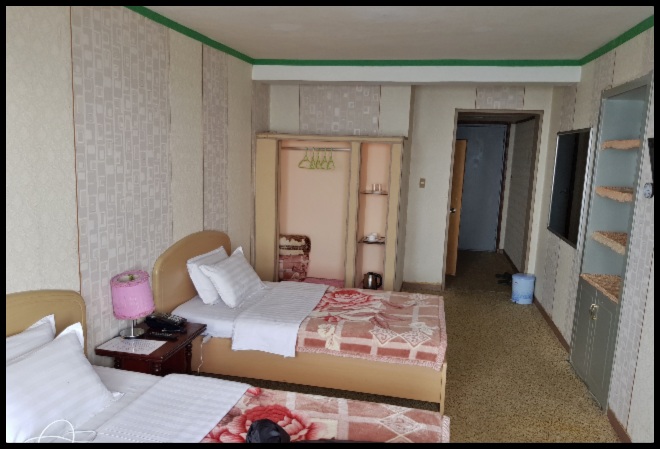

The rooms were dated but clean and, as I recall, I had no issues with water or electricity during my short stay. The beds were as hard as any in the country though this was not an issue for me as I prefer a firm bed and thus had a great night’s sleep.
Perhaps the best thing about the room was the view, though to enjoy that the window, in need of the services of an external window clearer and a handyman with some WD40, as it didn’t exactly glide in its tracks, needed to be cajoled into opening.
Leaving aside the quality of the window, all rooms are positioned such that residents can enjoy views out to sea and along the coast (north or southwards depending on the room).
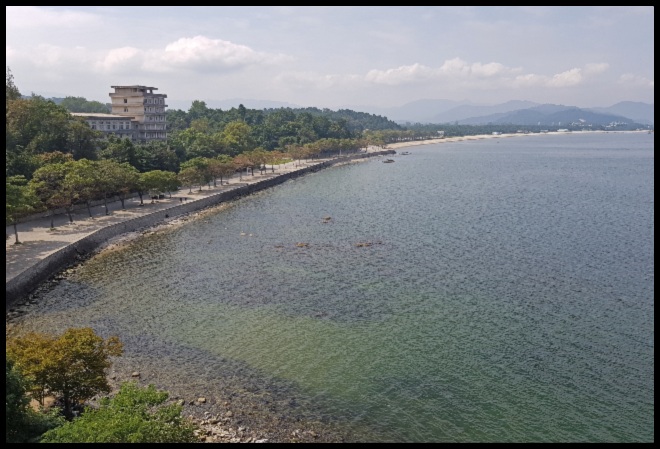
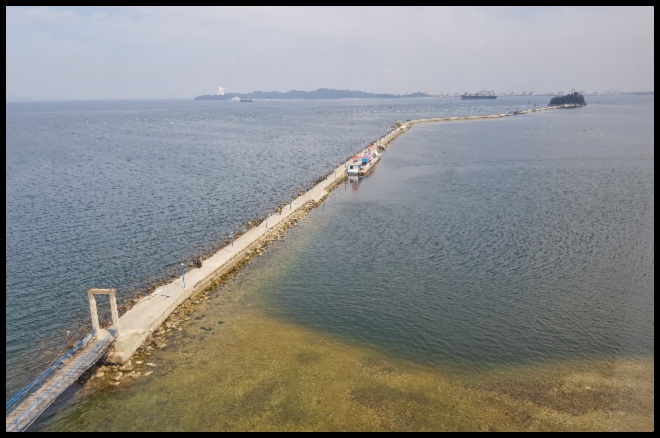
While I didn’t realise it as the time, looking northwards, in addition to a very popular coastal walkway and beach (in summer) I had a distant view of Kim Jong-un’s luxury resort/private retreat. Though it was too far away to see anything of interest I have subsequently gone through my photos and ‘zoomed’ in on one to reveal what I think is Kim Jong-il’s former residence, within the extensive compound, and the resorts marina/boat house. The larger buildings in the foreground below are part of the Songdowon International Children’s Camp which I did visit.

In terms of hotel facilities, I didn’t have time to partake of much and the only thing I noticed were some table tennis tables, in addition to a small rather dull lobby shop/ Kim orientated bookshop.

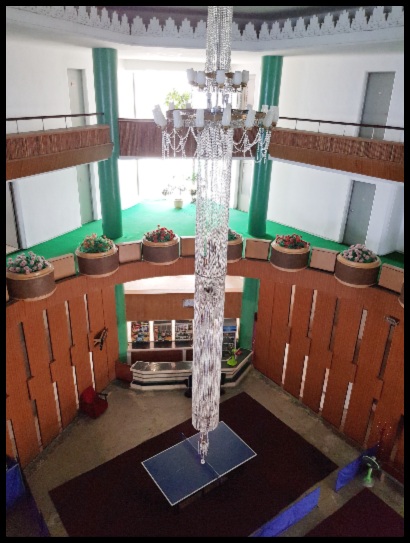

The hotel also sports a sauna and heated seawater pool though I didn’t visit either so cannot comment on them.
All in all the hotel was adequate with the ample supply of kitsch fixtures and fittings that I had come to expect of a North Korean hotel.

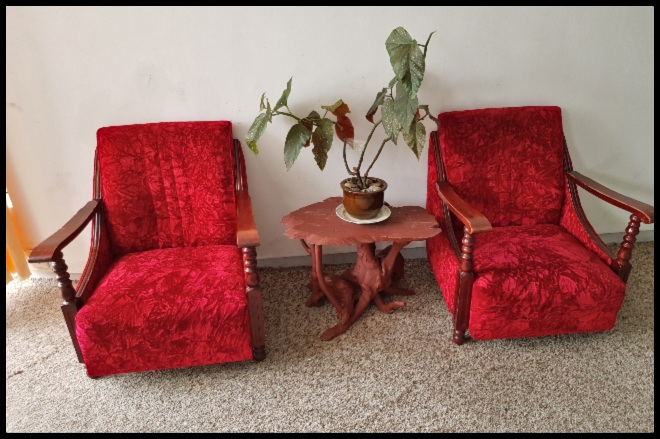

While we had a distinctly unmemorable (not bad) breakfast at the hotel we ate both lunch and dinner at the appropriately named Tourist Restaurant, about 10 minutes walk away.
En-route to dinner I received a reprimand (the only one on this trip) for taking a photograph. Interestingly the reprimand came from our bus driver and not from one of the guides. While I was very familiar with the (generally flaunted rule) that photographing trains and railway infrastructure was not permitted I did not realise that this extended to a ban on taking pictures of pictures of trains!

As I felt fairly confident that the above photograph was not in contravention of the Democratic People’s Republic of Korea’s photography rules I sought a formal judgement on my alleged misdemeanour from our senior local guide. My taking the photograph was adjudged to be perfectly within the law and I was able to retain the photograph while the bus driver was spoken to! No, he was not sent off to a re-eduction camp!!!
Dinner itself was par for the course and pleasant enough, featuring a few fish dishes, given our proximity to the coast.
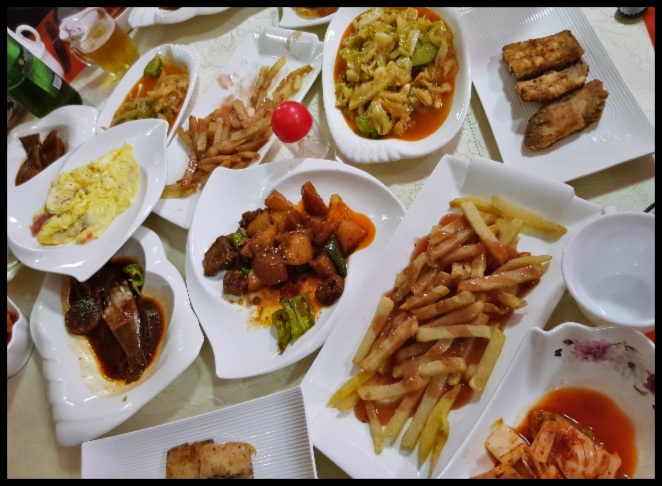
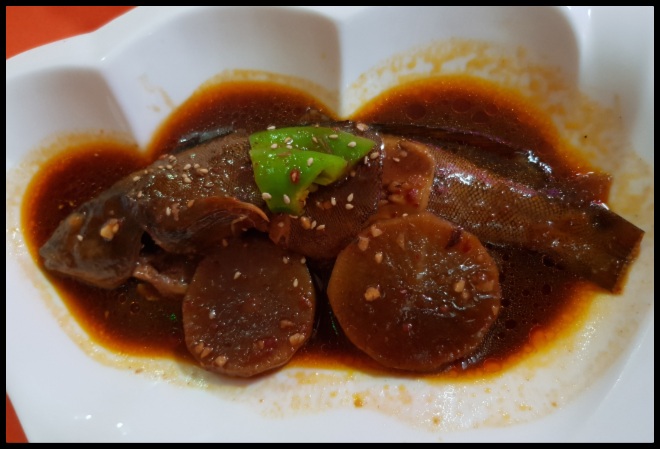
After dinner, which was a little later than usual as we had taken a sunset walk out to Jangdok Islet before eating, I retired to my room and decided to partake of a little of the hotel’s ‘televising’ offering.
I settled on a re-run of a spectacular torchlight display held as part of the festivities for the 70th anniversary of Foundation Day, a few days earlier in Pyongyang. While we saw thousands of participating students gathering for the display earlier in the day and encountered them again, dispersing, after we had watched an associated fireworks display we were not permitted to attend the torchlight display itself, in Kim Il-sung Square.

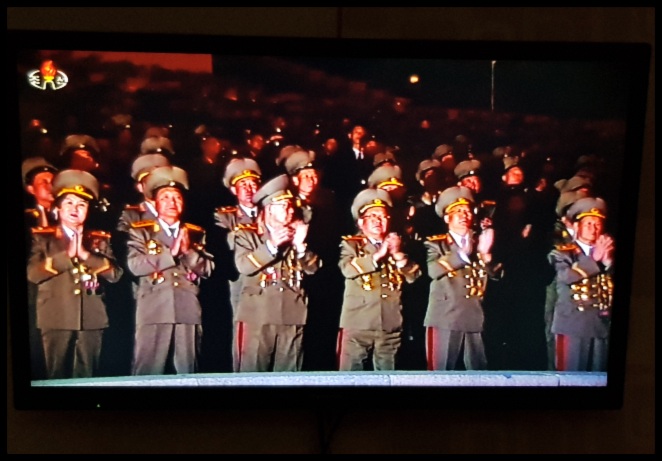
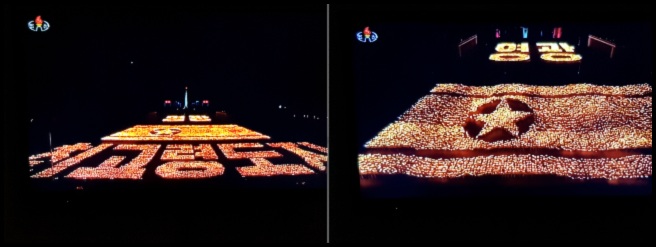
Lest you think it a little odd that I would take photographs of the television I should explain that this was a ( strange) habit most of the group developed a few days earlier in Pyongyang when we could not get into Kim Il-sung Square, or anywhere along the route of the main military parade, to celebrate the 70th anniversary of the foundation of the DPRK. We ended up (quite a story for a later Pyongyang post) watching the parade live in a coffee shop near the Kwangbok Department Store and somehow started taking photos of the television screen. At least we could prove we saw the parade live (albeit on TV) in Pyongyang, if not in Kim Il-sung Square! I think our guides and the coffee shop staff thought we were mad as I imagine my reader does too!
After ‘taking a few photos of the torchlight parade’ I nodded off to sleep, to the stirring yet soothing strains of the patriotic music accompanying the TV presentation.
My next North Korea – Wonsan 2018 review HERE
Return to the beginning of my North Korea (2018) – Wonsan reviews – HERE




Wow! The no photography rule (the first of its kind I’ve heard ) must have really let you live in the moment, all your five senses on high alert. The fish on the wheels though looks interesting. I’m happy there was a photo for that 😊.
LikeLiked by 1 person
Thank you for commenting .. I appreciate your feedback. Probably 80-90% of the rules are as per anywhere you travel – its just that other countries don’t go to the same extent of ‘publishing’ and policing rules. So no photography of military bases and infrastructure, inside some museums and sticking camera’s in peoples faces without permission (really common courtesy) for example apply everywhere. In NK they have the added rule of not taking photographs of things which portray the country in a bad light. This is difficult to understand for non North Koreans especially as what it covers varies a bit from guide to guide. In short they argue that some people (not just people taking the photos) use negative photographs solely to denigrate the country and Leadership to a greater degree then is done for other countries when the reality is that the poverty, lack of cars, (due to lack of fuel), old rattling trams etc etc is due to external factors (namely US lead sanctions). If you follow NK news you would see that this is the case. Personally I don’t agree with this aspect of their policy as photos they don’t like still get taken and used anyway. They are fighting a looking battle and would be better focusing people’s attention on why things are not perfect as opposed to having people focus on what appears to them to be dictatorial rules.
LikeLiked by 1 person
Now when I think of it , it’s true about no photography rule as being common. We too have it and I noticed the same in some other countries. I guess what surprised me was the picture of a train sign creating the photography drama. Anyway , thank you for that detailed explanation. I enjoyed taking a peek into this part of the world .
LikeLiked by 1 person
There are a few extra rules in NK (not in their interest in my view) and enforcement is stronger. Glad you enjoyed have a peak through my blog and I hope you stay tuned as there is more on this fascinating country to come.
LikeLiked by 1 person
A picture is worth a thousand words and you have plenty here 🙂
LikeLiked by 1 person
Thanks Malc :-). Agree .. also I took so many pics in NK its very tempting to publish with gay abandon. Do you remember how we were limited to 5 per post in VT?
LikeLiked by 1 person
I certainly do. That’s what I like about having a website. You can put on there whatever you want
LikeLiked by 1 person
I hear the 1079s calling! I don’t think I’ve ever seen a fraacef adornment before.
LikeLiked by 1 person
Thanks for you visit Anabel…’fraacef ‘ is not a term I am familiar with … from Glasgow ?
LikeLike
Freezer! How on earth did that happen?
LikeLiked by 1 person
Not even close lol… I also wondered about your reference to the 1079s but didn’t want to query two things at once !!!
LikeLike
1970s! Was I drunk? Or possibly on my phone in which case could be fat finger syndrome. I’ll go with the latter as being more dignified.
LikeLiked by 1 person
I was thinking a wee dram was involved lol
LikeLiked by 1 person
You won’t be surprised to hear that I don’t find it odd at all that you took photos of the TV 😆 In fact, I did the same myself once in Japan!
We didn’t stay in Wonsan but spent the day there. I recall that our bus was parked in the car park of a hotel looking much like the one at the top of your page (which I assume is the Dongmyong?) It was almost opposite a good art shop and near the restaurant where we had lunch, one of the better meals we had in N Korea. We were told Michael Palin had celebrated his birthday in a private room there and were even shown the room!
I know I took photos of similar train photos to yours, so I guess it’s good to know I wasn’t breaking any rules while doing so. The one about not photographing trains had somehow been missed off our briefing so when we were stopped at a level crossing somewhere near Wonsan (I think), everyone whipped out their cameras to photograph the train going past, only to be shouted at to put them away!!
LikeLiked by 1 person
I am happy to hear others take TV screen shots too!
As there are now train tours I assume the rules has been relaxed a bit, though of course the issues around the trains themselves is that they are old and battered looking – portraying the country in a bad light in their eyes.. They are really touchy on photographing infrastructure like stations, junctions, bridges etc but really anyone interested in the same can just jump on google Earth .. they don’t even need military satellite images. I really do think their photography rules need a serious review as the rules themselves ( which are increasingly difficult to enforce) which are talked about around the world than the photos do the country and Leadership more harm than publication of the photos people take could ever do. As I wrote on another comment they should focus on promoting overseas why everything is not perfect in NK. They know and accept there are issues but persist in trying (without success) to hide them.
For some reason (which I could suggest) people look at photos from NK in a different light then they look at photos from other countries. If you post a positive photo (eg the colourful buildings in Pyongyang) you are accused of photoshopping, promoting the regime or both .. if you post a photo of an ox pulling a cart it is taken to prove that the whole country has failed and people are dying in the streets due to internal problems and awful leadership even though poverty in many countries is much worse than in NK and the use of oxen in farming goes unremarked or is even seen as something ‘cute’ ….You cannot win!
Yes the hotel featured is the Dongmyong. It is also possible that you parked at the Songdowon Hotel which is between the Dongmyong and the art shop you refer to (assuming that to be the one you (and I ) visited that did not allow photos inside). From the street side the two hotels look similar though the Songdowon is green in colour. Of course, on Tripadvisor pictures of one hotel appears on the review of the other and vice versa though that would not be a shock to you. I wonder if the restaurant we ate at was the same as you as it was close to the art-shop too. There would not be a large number of restaurants they take tourists too…
LikeLiked by 1 person
Looking at the map I think you are right – it was the Songdowon where we parked. I remember it was right by the spot where people were fishing over a balustrade (second photo on https://toonsarah.travellerspoint.com/396/). I also have a photo of the entrance to the art shop there. That day we ate lunch in one of the hotels (again I think the Songdowon) but we’d eaten in the restaurant near the art shop, which I think is called Kalmaegi, a couple of days previously – I have a few photos here: https://toonsarah.travellerspoint.com/391/
I completely agree with all your comments about photography in the DPRK. I think their over-vigilance does them a disservice and has more impact on negative impressions of the country than a few ox cart photos would ever have.
I have another notification from you relating to a comment about split paragraphs and yellow flashes which doesn’t seem to be here on the page and didn’t make much sense to me – am I missing something somewhere?!
LikeLiked by 1 person
Good to see you see the photography rules the same way as I do.
Please ignore the second notification as I deleted the message .. it related to what I thought were problems with the first post but in the end it went through as intended.
LikeLiked by 1 person